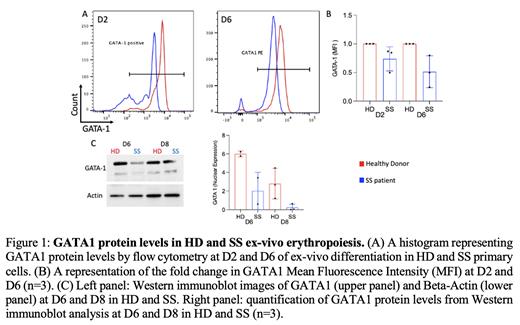Background & Objectives: Ineffective erythropoiesis (IE) is an important factor in many types of anemias, including beta-thalassemia. Recently, a study by El Hoss et al provided compelling evidence for IE being an important part of the pathophysiology of sickle cell anemia (SCA) (PMID: 32855279). Furthermore, we developed a clinical index to measure IE and showed that patients with the SS genotype, but not SC, had increased IE compared to healthy donors (HD) (PMID: 34670360). However, the molecular mechanisms of IE in SCA, its relationship to disease heterogeneity and its potential as a therapeutic target, remain unknown. Importantly, GATA1, an essential erythroid transcription factor known to be downregulated in haematological conditions presenting with IE, has not been previously investigated in SCA. Thus, the aim of this project is to investigate the molecular basis of IE in SCA by focusing on GATA1 functions in erythropoiesis.
Methods: HUDEP-2 cells, gene-edited sickle HUDEP-2 (SS HUDEP-2) (PMID: 32405513) cells and CD34+ cells isolated from individuals with HbSS and healthy donors, were differentiated ex vivo using a two-phase culture and (i) erythroid differentiation kinetics, (ii) markers of oxidative stress, (iii) GATA1 expression and (iv) antioxidant response factors NRF2, FOXO3 and heme-oxygenase 1 (HO-1) were assayed every other day during phase 2. IE was also studied in SS Berkeley transgenic mouse (PMID: 16166585). Both the spleen and the bone marrow were investigated in AA, AS and SS mice.
Results: No significant differences were observed in the differentiation kinetics and in levels of oxidative stress in in vitro differentiated HUDEP-2 and SS HUDEP-2 cells. Moreover, GATA1 levels were similar in both cases. Importantly, ex vivo differentiation of human SS CD34+ cells showed a striking delay accompanied by high oxidative stress and a decrease in GATA1 protein levels (Figure 1) compared to normal controls. We also found a significant decrease in FOXO3, NRF2 and HO-1 levels in SS erythroblasts compared to healthy donor erythroblasts. IE was evident in SS mice compared to AA and AS controls. SS mice presented with higher levels of reactive oxygen species (ROS) in both the bone marrow and the spleen tissue. Histological studies showed that the SS Berkley mouse has a very congested bone marrow with a disorganized architecture. Moreover, we showed a significant decrease in GATA1 protein in SS spleen and bone marrow erythroid cells.
Conclusion: Using ex vivo differentiation of primary SS cells and an in vivo mouse model for SCA, we show for the first time that aberrant GATA-1 levels play a key role during IE in SCA. During SS erythropoiesis, a significant reduction in the protein levels of the GATA1 erythroid master transcription factor and of FOXO3 and NF-E2, important transcriptional regulators of the oxidative stress response occur. These same changes were not seen in SS HUDEP-2 cells, suggesting that abnormalities of the bone marrow niche are central to abnormal erythropoiesis in SCA. Modification of the bone marrow niche and manipulation of GATA-1 levels may be important therapeutic tools in SCA.
Disclosures
Conran:Novartis Pharma AG: Research Funding.


This feature is available to Subscribers Only
Sign In or Create an Account Close Modal